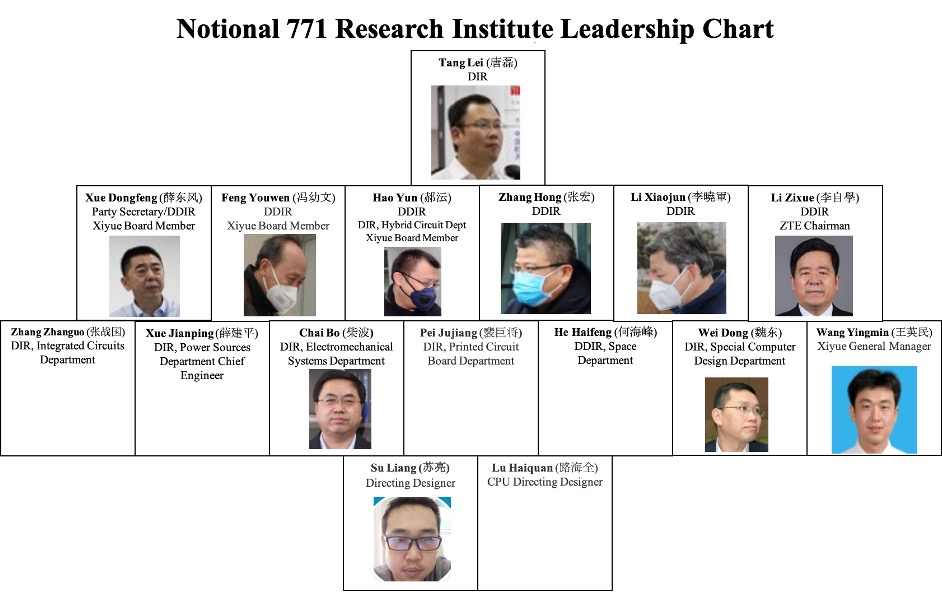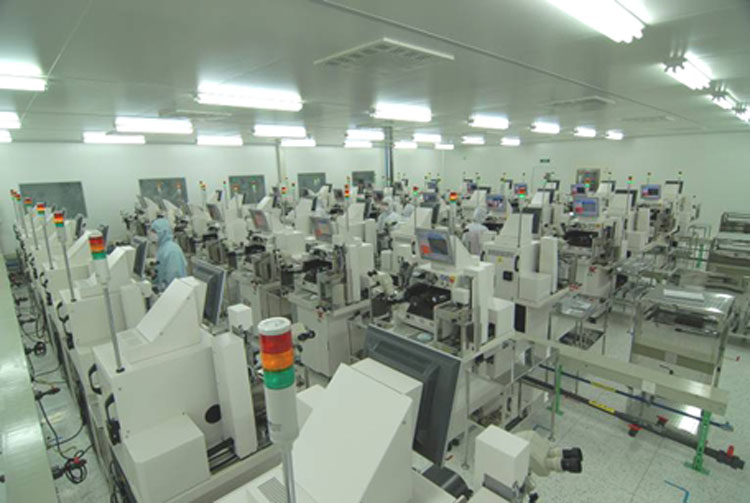By: Eric Lee and Seamus Boyle

Microelectronics are driving China’s expanding and increasingly sophisticated space and intercontinental ballistic missile (ICBM) force. Integrated circuits are core components in ICBM and space guidance, navigation, and control (GNC) sub-systems, which are instrumental for delivering aeronautic vehicles and missile payloads to designated targets. The China Aerospace Science and Technology Corporation (CASC) Ninth Academy, also known as the China Academy of Aerospace Electronics Technology (CAAET), is responsible for detailed design and manufacturing of missile-borne computers, missile guidance sets, and associated components. The CASC Ninth Academy’s 771 Research Institute is perhaps the most important supplier of military-grade chips that guide People’s Liberation Army (PLA) ICBMs to their intended targets. This article features the 771 Institute as a critical node in the PLA ballistic missile supply chain.
Background
CASC is the sole supplier of intermediate- and intercontinental-range ballistic missiles to the PLA Rocket Force (PLARF) and Navy. The PLARF Equipment Department is responsible for planning, programming, and budgeting China’s ICBM force modernization. Among other systems, the PLARF currently is equipped with the liquid-fueled DF-5, including a multiple independently targetable reentry vehicle (MIRV) variant, solid-fueled DF-31A ICBM, and mobile and solid-fueled MIRV DF-41 ICBMs. More specifically, the Equipment Department develops technical requirements, manages major acquisition programs, and oversees repair and maintenance of ICBMs and other weapon systems. The PLARF Equipment Department relies heavily upon the PLARF Research Academy and at least seven subordinate research institutes.
 (Figure 1: DF-41 Notional Systems Engineering Organization Chart. Source: “The Project 2049 Institute.”)
(Figure 1: DF-41 Notional Systems Engineering Organization Chart. Source: “The Project 2049 Institute.”)CASC’s China Academy of Launch Technology (CALT) supports the PLARF Equipment Department through overall systems engineering. CALT, also known as the CASC First Academy, oversees a large design department that manages and integrates the technical efforts of research institutes and factories, such as the First Academy’s 10th Research Institute (post-boost hypersonic glide vehicles), 12th Institute (overall GNC design), 14th Research Institute (reentry vehicle design), and 15th Research Institute (launcher design). On technical matters, the First Academy also oversees sub-system designers administratively housed within other CASC research academies. For example, the CASC Fourth Academy is responsible for solid motor propulsion systems, CASC Sixth Academy for liquid engines, and CASC Ninth Academy for detailed design of GNC assemblies and components. The China Academy of Engineering Physics (CAEP), which is administratively independent of CASC, is the PLA’s sole supplier of nuclear warheads designed for delivery on CASC launch vehicles. Putting warheads to the side, unique technical requirements associated with ballistic missiles naturally drive CASC toward vertical integration.
The China Academy of Aerospace Electronics Technology
The CASC Ninth Academy’s primary mission is to supply CALT and PLARF end users with GNC electronic assemblies and components. Employing about 16,000 personnel, the Ninth Academy carries out detailed design and fabrication of inertial navigation systems; telemetry, test, and termination systems; and associated components such as gyroscopes, accelerometers, microelectromechanical systems (MEMS), integrated circuits (ICs), hybrid circuits (HCs), cables, and electric wires. The Ninth Academy also designs and produces unmanned aerial vehicles (UAVs), tactical precision guided munitions, and invests significantly into Internet of Things (IoT) technologies.[1]
CAAET’s Ninth Design Department likely works closely with an ICBM variant’s chief designer housed within CALT’s First Design Department, and a deputy chief designer with overall responsibility for the GNC sub-system. The GNC sub-system designer presumably resides within CALT’s 12th Research Institute (Beijing Institute of Aerospace Automated Control). The 12th Institute hosts the National Defense Key Lab for Guidance and Control Technology (制导与控制技术国防科技重点实验室), which is overseen jointly by the Central Military Commission (CMC) Equipment Development Department and PLARF Equipment Department. (Figure 2: Organizational Structure of CASC Ninth Academy. Source: “The Project 2049 Institute.”)
(Figure 2: Organizational Structure of CASC Ninth Academy. Source: “The Project 2049 Institute.”)
 (Figure 2: Organizational Structure of CASC Ninth Academy. Source: “The Project 2049 Institute.”)
(Figure 2: Organizational Structure of CASC Ninth Academy. Source: “The Project 2049 Institute.”)Two core Ninth Academy entities — the 771 Research Institute (Xian Institute of Microelectronics Technology) and the 772 Research Institute (Beijing Institute of Microelectronic Technology) – carry out detailed design and fabrication of microelectronic components. The division of labor – or the degree of competition — between the two institutes remains unclear. The 772 Research Institute specializes in design and development of military-standard, very large-scale integrated (VLSI) devices, and ceramic packaging and mounting technology.
Diving Deep into the Xian Institute of Microelectronics Technology
The 771 Institute was established through restructuring of the former Chinese Academy of Sciences (CAS) 156 Engineering Office. Before the 156 Office, the former CAS 109 Factory had developed the 109B computer (109乙机) for China’s first hydrogen bomb. Following the success of the “Two Bombs, One Satellite” (两弹一星) program, in 1965 the CCP Central Special Committee tasked CAS to develop a computer for long-range missile guidance under the name ‘Project 156.’[2] The 156 Engineering Office integrated the work of six different CAS institutes, including the Institute of Computing Technology, Institute of Electronics, Institute of Physics, Northeast Institute of Physics, Institute of Computing Technology, and Changchun Institute of Applied Chemistry.[3] Prior to the name change of the 771 Institute to the Xian Institute of Microelectronics Technology, it was also known as Lishan Microelectronics Institute.[4]
Like most other Ninth Academy institutes and factories, the 771 Institute was subordinate to the CASC First Academy until the establishment of CAAET. The 771 Institute is highlighted for its significant contributions to China’s satellite, space launch vehicle, and ICBM programs. For example, the 771 Institute designed, developed, and assembled the onboard computer for the DF-5 ICBM.[5] The institute developed the 156 Computer (156计算机), the brains and nerve center of the Long March-2 launch vehicle.[6] The LM-2 launch vehicle was configured to deliver nuclear payloads to targets in the continental United States. The 771 Institute has also had a significant role in China’s forthcoming Tienwen-1 mission to Mars, having developed remote viewing and data system central processing units (CPUs) for its Mars rover as well as radiation-hardened LSCCU01RH computers for the Long March-5 launch vehicle.[7]
Subsequent to the deployment of the DF-5 to the PLA in the early 1980s, the 771 Institute became a beneficiary of China’s defense conversion (军转民) program and spun off a commercial enterprise, Zhongxing Telecommunications (ZTE).[8] Until today, the 771 Institute holds 34% ownership of ZTE.[9] Former 771 Institute engineers have been employed by ZTE. ZTE founder Hou Weigui (侯为贵) was previously an engineer with the 771 Institute.[10] Former 771 Institute director Tian Dongfang (田东方), as well as deputy director and party committee secretary Li Zixue (李自學), have sat on ZTE’s board of directors since November 2018. Tian Dongfang left the 771 Institute to serve as ZTE’s party secretary.[11] Li Zixue maintained his position as deputy director of the 771 Institute while dual-hatted as ZTE’s board chairman.[12] Minimal reporting on Li’s connection to the 771 Institute has emerged in the time after ZTE violated U.S. sanctions on Iran and the U.S. Department of Commerce imposed a denial of export privileges against ZTE.[13] (Figure 3: Notional 771 Institute Leadership Chart. Source: “The Project 2049 Institute.”)
(Figure 3: Notional 771 Institute Leadership Chart. Source: “The Project 2049 Institute.”)
 (Figure 3: Notional 771 Institute Leadership Chart. Source: “The Project 2049 Institute.”)
(Figure 3: Notional 771 Institute Leadership Chart. Source: “The Project 2049 Institute.”)Today, the 771 Institute’s 5,000 employees conduct R&D in three general areas: military computing systems, monolithic ICs, and hybrid circuits.[14] The 771 Institute develops application specific ICs (ASICs), radiation-hardened ICs, field programmable gate arrays (FPGAs), digital signal processors (DSPs), system on chip (SoC), multi-chip modules (MCMs), system in a package (SiP), memory devices, CPUs, MEMS, radio-frequency integrated circuits (RFICs), analog to digital converters (ADC), digital to analogue converters (DAC), and printed circuit boards (PCBs). Such microelectronics provide both central and peripheral functionalities within GNC sub-systems, and avionics microelectronic systems benefit from weight and power efficiency. For example, MEMS devices provide low power and low mass avionics solutions, such as sensors for telemetry and inertial navigation. FPGAs are flexible in configuration and have military applications from advanced sensors to electronic warfare, encryption, radars, and artificial intelligence. SiP stacks different components, such as ASICs and memory chips, in a space-saving package.
According to a 771 Institute press release, the institute is essentially an integrated device manufacturer (IDM), maintaining vertically integrated design, processing, manufacturing, testing, screening and simulation capabilities.[15] The institute’s research tends toward optimizing the power efficiency of its microelectronic systems. Among a sampling of its research are embedded system structures, microprocessor and system chip design, analog circuits, electric power converters, converter modeling, semiconductor process simulation, technology, high-speed signal conversion and processing, embedded systems, real-time image processing, and parallel computing.[16]
The institute’s leadership consists of a director, Communist Party committee secretary, a chief engineer, and at least five deputy directors. The leadership oversees at least eight departments, responsible for: weapon systems and launch vehicles, power sources (电源部), a “special department” (特种部), space computer systems (宇航部), manufacturing (制造部), electromechanical systems (机电系统部), hybrid circuits (混合电路部), and hybrid power sources (混合电源部).[17] Directing designers (主任设计师) are assigned responsibility for the development of components supporting a CALT GNC sub-system.
 (Figure 4: Notional 771 Institute Leadership Chart. Source: “The Project 2049 Institute.”)
(Figure 4: Notional 771 Institute Leadership Chart. Source: “The Project 2049 Institute.”)The 771 Institute oversees a Hybrid IC Design Center (混合集成电路设计中心), an Aerospace MCM Micro Assembly Center (航天MCM微组装中心), and a Special Computer Manufacturing Center (特种计算机制造中心).[18] Hybrid IC research is focused on thick film technology, low temperature co-fired ceramic (LTCC) substrate hybrid circuits, and MCMs.[19] The 771 Institute is a trusted supplier to the PLA and manages two military-standard IC foundries.[20]
The institute’s publicly reported IC processing capability ranges from 5µm to 0.35µm.[21] It is conducting R&D on the 0.25µm node.[22] Unlike hybrid ICs, which are formed by interconnecting different chips, monolithic ICs are fabricated entirely on a single chip. Smaller, denser chips allow more computing power in less space. The current state-of-the-art for ICs in 2020 is the 5nm node. For reference, Taiwan Semiconductor Manufacturing Company (TSMC) is mass producing 5nm chips and conducting R&D on the 3nm node and beyond.[23] The 771 Institute reportedly has the capacity to produce 20,000 wafers per month on 4” and 6” sized wafers. Manufacturing is focused on eight categories: complementary metal-oxide-semiconductor (CMOS), silicon on insulator (SOI) CMOS, bipolar junction transistors (BJT), aluminum gate CMOS, vertical double-diffused metal–oxide–semiconductor field-effect transistor (VDMOS), discrete devices, electrostatic discharge (ESD) protection devices, and uncooled infrared sensors.[24] CMOS devices tend to have low static power consumption and high noise immunity. Design has focused most on CPUs, DSPs, SoCs, bus interface devices, memory chips, comparators, power management ICs, and CMOS image sensors.[25]
 (Figure 5: 771 Institute Monolithic IC Equipment. Source: “Xian Institute of Microelectronics Technology.”)
(Figure 5: 771 Institute Monolithic IC Equipment. Source: “Xian Institute of Microelectronics Technology.”) (Figure 6: 771 Institute Hybrid IC Equipment. Source: “Xian Institute of Microelectronics Technology.”)
(Figure 6: 771 Institute Hybrid IC Equipment. Source: “Xian Institute of Microelectronics Technology.”)The 771 Institute allegedly also conducts R&D on uniquely configured military computers, including design, testing, production, and assembly. Computing R&D is focused on architecture, SoC and SiP applications, and localizing computer bus technology.[26] The 771 Institute’s primary computing products are onboard computers for missiles, air/spacecraft, satellites, and naval vessels. These are systems’ nerve-centers for processing information and data.[27] Additional products include ruggedized computers, microelectronic and power components, and PCBs.[28] The 771 Institute publishes the journal Microelectronics & Computer (微电子学与计算机).[29]
The 771 Institute also has two commercial units that directly support the PLA — Xian Tai-E Electronics Company and Xian Xiyue Electronics Technology Co. Tai-E is a wholly owned 771 unit that inspects and ensures quality control of military standard electronic components for space systems, missiles, aircraft, ships, and munitions. The Tai-E Electronics Center (太乙電子中心) served the former PLA General Armaments Department (GAD), which is now the CMC Equipment Development Department. It also hosted a military laboratory and aviation semiconductor device failure analysis center, and maintained a space systems component quality assurance system.[30]
Xiyue appears to carry out commercial sales and a portion of 771 chip fabrication.[31] Xiyue has engineering and manufacturing departments, marketing departments, as well as training facilities dedicated to semiconductor fabrication. The 771 Institute owns 60% of Xiyue, with the other 40% held by the Ninth Academy.[32] Xiyue has three business focus areas: domestic and international IC design, integrated device manufacturing (IDM), and high-reliability special IC design (高可靠特种集成电路).[33] While information about specific clients and deals is unclear, it is likely that the 771 Institute’s technology is transferred and/or sold to overseas clients through Xiyue. A detailed list of Xiyue products can be found here.[34] (Figure 7: Xiyue Organizational Structure. Source: “Xian Xiyue Electronics Technology Co.”)
(Figure 7: Xiyue Organizational Structure. Source: “Xian Xiyue Electronics Technology Co.”)
 (Figure 7: Xiyue Organizational Structure. Source: “Xian Xiyue Electronics Technology Co.”)
(Figure 7: Xiyue Organizational Structure. Source: “Xian Xiyue Electronics Technology Co.”)PLA Supply Chain Linkages
While the exact details of engagements are unknown, the 771 Institute plays a key role in PLA (especially to the PLARF and PLA Strategic Support Force) and defense industrial supply chains. Its parent, CASC, is a core supplier of finished weapon and space systems to the PLA. The former GAD enlisted Tai-E to host a quality control laboratory. The PLA also works closely with the 771 Institute on designated military-civil fusion projects, and with the Shanxi Military-Civil Fusion Committee serving as a partner.[35] The 771 Institute also has close relations with a number of PLA representative offices based in the Xian area. The PLARF (probably the PLARF Equipment Department) maintains a Xian Area Representative Office. The 771 Institute is likely a key supply chain management partner in repair and maintenance of PLARF ballistic missile systems. In addition, the PLA Navy’s Xian Region Second Representative Office, and the PLA Air Force Equipment Department’s Xian Region Eighth Representative Office, all send directors from their respective offices to participate in the 771 Institute’s conferences and meetings.[36]
771 Institute and China’s Space Program
Beyond its role in the ICBM supply chain, the 771 Institute also supports CASC’s Fifth Academy (China Academy of Space Technology). The Fifth Academy encompasses several specialized centers, research institutes, and factories dedicated to the development of China’s space technology. In supporting major projects, such as the Chang’E, the 771 Institute has supplied the CASC Fifth Academy with space qualified ICs and other components. Known Fifth Academy partners include the 502 Institute (Beijing Institute of Control Engineering), 504 Institute (Institute of Space Electronic Information Technology, and 513 Institute (Shandong Institute of Space Electronic Technology).[37]
The 771 Institute has collaborated with CAST’s Control and Propulsion System Department to develop spacecraft guidance, navigation and control systems, as well as propulsion-related program control systems. Aligning with U.S. military standards (MIL-STD 1553), their partnership involves supplying DC/DC converters along with VDMOS, FPGA to ASIC conversion, and power control unit technology, citing the need for increased production to support 502 Institute projects.[38]
The Fifth Academy’s 504 Institute (Xian Institute of Space Radio Technology) has been one of the 771 Institute’s closest partners. In 2014, the two institutes signed a strategic cooperation agreement. In 2016, at a meeting at 771 Institute headquarters, 504 Institute director Li Jun (李军) proposed the signing of a follow-on agreement that would allow for free exchange of personnel and resources between the two institutes.[39]
The Fifth Academy’s 513 Institute has collaborated with the 771 Institute as recently as 2019. At the second Software-Defined Satellite Technology Alliance (年软件定义卫星技术联盟) meeting in Beijing, the two institutes sought to shape the direction of China’s major aerospace developments.[40]
The 771 Institute also serves as a supplier to CASC’s sister enterprise, the China Aerospace Science and Industry Corporation (CASIC), specifically CASIC Third Academy’s 31st Institute (Beijing Institute of Power Machinery cruise missile engines).[41] It also has been noted collaborating with CASC Eighth Academy 811 Institute (Shanghai Institute of Space Power Sources).[42] The 771 Institute has also partnered with the Nanjing University of Science and Technology[43]; Zhengzhou Aviation Experimental Zone[44]; Daweiduo Enterprise Management (达维多企业管理有限公司)[45]; and Longson Zhongke Technology (龙芯中科技术有限公司).[46]
Key Takeaway
Based on available sources, the 771 Institute appears to play a significant role in China’s military technology supply chain. The institute could be responsible for R&D of as much as 85% of China’s aerospace mission computers.[47] The 771 Institute likely supplies critical microelectronic components to the PLA, large CASC missile development programs, and engages in commercial business through subsidiaries such as Xiyue. Putting capital equipment to the side, the institute reportedly integrates all parts of the integrated circuit supply chain, including design, fabrication, testing, assembling, and packaging.
The Central Military Commission invests significant resources to rapidly advance China’s technology prowess. The PLARF ICBM expansion program likely relies on CASC Ninth Academy to supply advanced missile guidance set assemblies, including computers and microelectronic components. While the 771 Institute alleges to be at the cutting-edge of China’s microelectronics technology research and development, it appears to lag behind in areas such as advanced semiconductor manufacturing; the institute does not appear to have entered the nanometer level. The institute aims to be an IDM but is likely more of a device integrator. In short, the 771 Institute’s questionable manufacturing capabilities likely provide potential exploitable vulnerabilities in the PLA’s military technology supply chain.
No comments:
Post a Comment